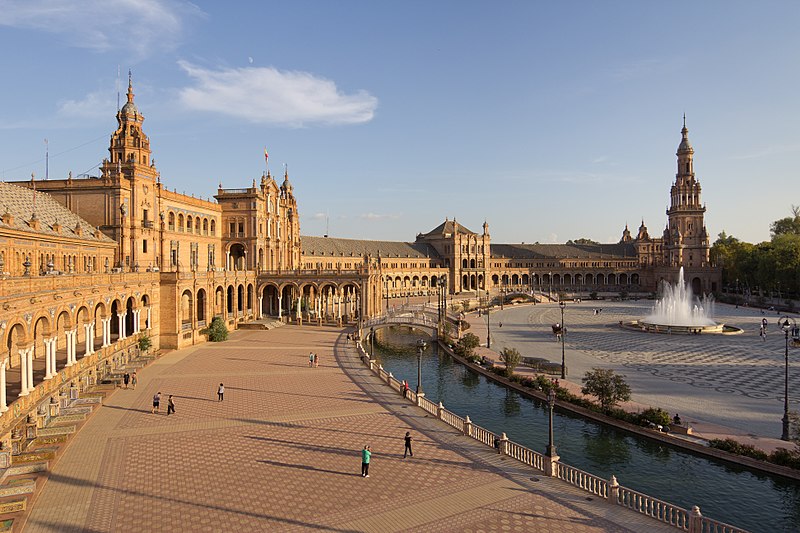Hello ladies and gents this is the Viking telling you that today we are talking about
The Plaza de España
The Plaza de España ("Spain Square", in English) is a plaza in the Parque de María Luisa (Maria Luisa Park), in Seville, Spain. It was built in 1928 for the Ibero-American Exposition of 1929. It is a landmark example of Regionalism Architecture, mixing elements of the Baroque Revival, Renaissance Revival and Moorish Revival (Neo-Mudéjar) styles of Spanish architecture.
History
In 1929, Seville hosted the Ibero-American Exposition World's Fair, located in the celebrated Maria Luisa Park (Parque de María Luisa). The park gardens were designed by Jean-Claude Nicolas Forestier. The entire southern end of the city was redeveloped into an expanse of gardens and grand boulevards.
The centre of it is Parque de María Luisa, designed in a "Moorish paradisical style", with a half mile of tiled fountains, pavilions, walls, ponds, benches, and exhedras; lush plantings of palms, orange trees, Mediterranean pines, and stylized flower beds. Numerous buildings were constructed in the park to provide spaces for the exhibition.
Plaza de España
The Plaza de España, designed by Aníbal González, was a principal building built on the Maria Luisa Park's edge to showcase Spain's industry and technology exhibits. González combined a mix of 1920s Art Deco and Spanish Renaissance Revival, Spanish Baroque Revival and Neo-Mudéjar styles. The Plaza de España complex is a huge half-circle; the buildings are accessible by four bridges over the moat, which represent the ancient kingdoms of Spain. In the centre is the Vicente Traver fountain.
Many tiled alcoves were built around the plaza, each representing a different province of Spain. The Plaza's tiled Alcoves of the Provinces are frequent backdrops for visitors' portrait photographs, taken in their own home province. Each alcove is flanked by a pair of covered bookshelves, now used d by visitors in the manner of a "Little Free Library". Each bookshelf often contains works with information about their province. Visitors have also donated favorite novels and other books for others to read.
Today the buildings of the Plaza de España have been renovated and adapted for use as offices for government agencies. The central government departments, with sensitive adaptive redesign, are located within it. Toward the end of the park, the grandest mansions from the fair have been adapted as museums. The most distant museum contains the city's archaeology collections. The main exhibits are Roman mosaics and artefacts from nearby Italica.
The Plaza de España has been used as a filming location, including scenes for Lawrence of Arabia (1962). The building was used as a location in the Star Wars movie series Star Wars: Episode II – Attack of the Clones (2002) — in which it featured in exterior shots of the City of Theed on the Planet Naboo. It also featured in the 2012 film The Dictator.
The plaza was used as a set for the video of Simply Red's song "Something Got Me Started".
Restoration
From 2007 to 2010, the Seville City Council invested 9 million euros in the restoration of the Plaza de España. The objective was to recover the original monument as the architect, Aníbal González, conceived it. To restore it, the restoration team worked to recover pieces such as the ceramic streetlights, benches, and even pavements.
In other cases, they created reproductions of elements based on photographs and postcards from the municipal newspaper library. Cefoarte and Diaz Cubero were some of the experts who worked in multidisciplinary teams to restore this complex to lively use.
And as always have a chilled day from the Viking

Comments
Post a Comment